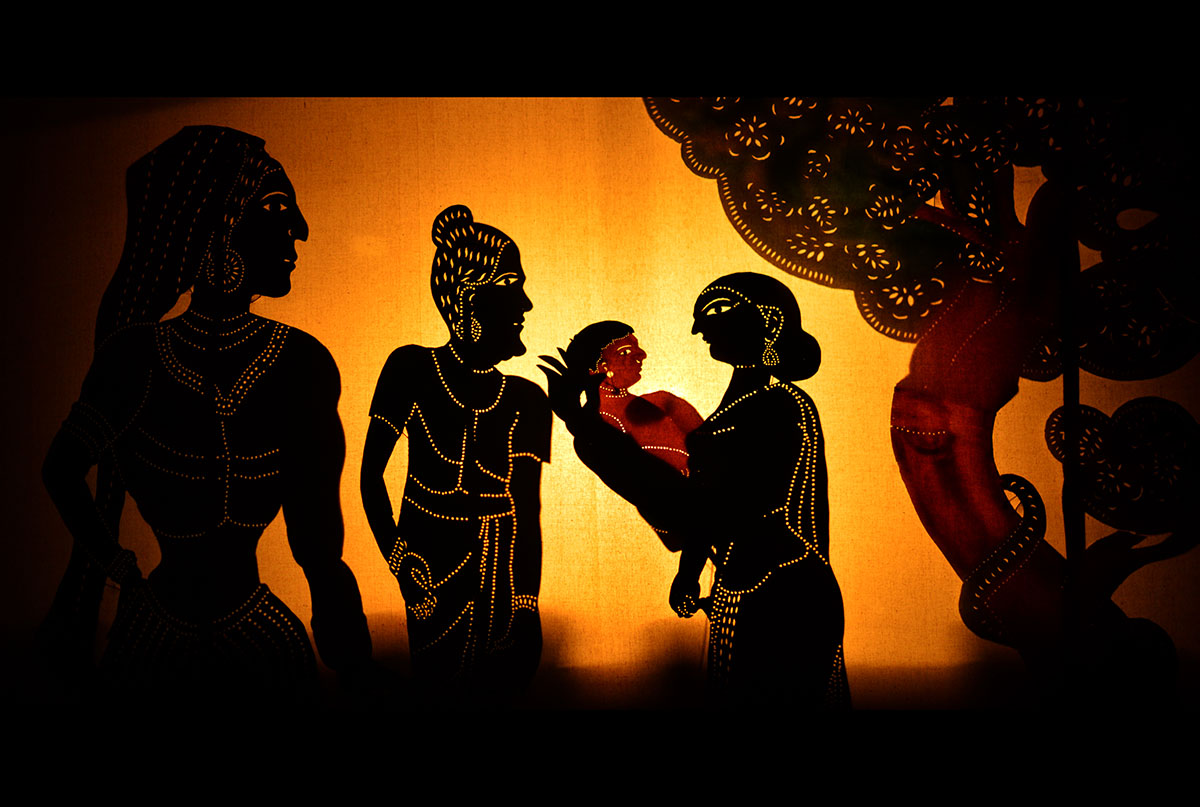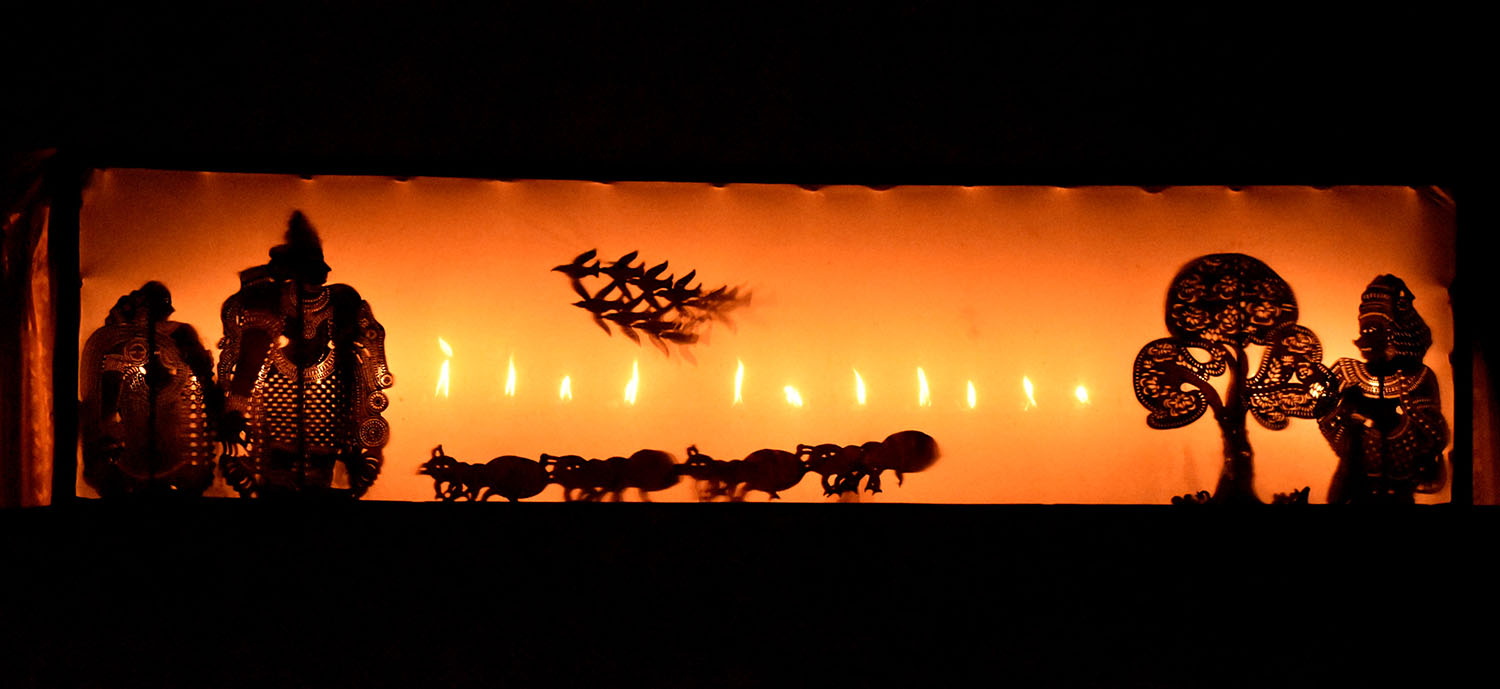ARTICLE
Tholpavakoothu
A form of shadow puppetry practised in the southern Indian state of Kerala, tholpavakoothu is a performing art and a ritual practice. Centred in the districts of Palakkad, Thrissur and Malappuram, the puppet plays are performed outside Bhadrakali temples with the belief that it is the goddess who is the primary audience of the play.
The base text of tholpavakoothu is the Kamba Ramayana, attributed to the Tamil poet Kamban and dated to the twelfth century. How the Kamba Ramayana came to be the base text for the performance remains unknown, although scholars of the art form suggest traders traversing the Palakkad Gap may have brought the text to the region. Historians believe a form of tholpavakoothu may have existed before the text was adapted for the art form, but state that the form’s repertory, as it exists now, can be dated to the seventeenth century. By the eighteenth century, the art form was popular, finding a mention in the poetry of Kuncan Nambiar.
As a ritual performance, tholpavakoothu plays are held in a special drama-house called koothumadam, built outside a Bhadrakali temple. The koothumadam is a three-walled, roofed structure, made of mud and wood. The fourth side serves as an open stage. Traditionally, koothumadam has been constructed in alignment with the temple’s entrance. An ideal structure is approximately 11.43 metres in length, 3.81 metres in height and 1.53 metres in depth, although these dimensions can vary slightly in other places. The white screen, made of cloth, is called ayapudava and is installed before a performance. The koothumadam is also equipped with villaku-madam, a rod that covers the length of the stage and serves as the stand for the oil lamps during a performance. The villaku-madam is fixed at a height of 1.3 metres. During a performance, the puppeteers hold the figures between the stand and the screen. In the off-season, with performance paraphernalia stored away and the open side covered with a wicker screen, the koothumadam is used as a social space.
Tholpavakoothu puppets, traditionally made of deerskin, are now made of goatskin. Once the hide has been treated, cleaned and dried to remove the fur, the outline of a character is made on it, and then chiselled. Needles and punches are used to create perforations that define costume, jewellery and iconography. A bamboo split is attached vertically along the length of the puppet for manipulation and to prevent wilting or curling. Figures of principal characters such as Rama and Ravana are made in three forms: seated, standing or walking, and in combat. The seated and standing versions have one articulated arm, manipulated by a different split, while the combat figure has two articulated arms. Principal characters are also large. For instance, the puppet depicting Rama can be 0.79 m in height and 0.46 m in width. Puppets of seated versions are crafted to show elements such as a throne within the same piece. The figures are painted in natural pigments but do not cast coloured shadows. Instead, the perforations create an opaque but filigreed shadow. Elements such as trees, forests, architecture, are also made of leather. An ensemble of 130 puppets, including animals and scenes, is used for the retelling of the Ramayana.
The tholpavakoothu season lasts from January to May, coinciding with the annual temple festivals. A performance can be held over 7, 14, 21 or 72 days, depending on the patronage. The troupe comprises five puppeteers and musicians who play the ezhupara (a percussion drum made of jackfruit wood and animal skin) and cymbals. The master puppeteer of a troupe is called pulavar, an honorific term for their knowledge of the text and mastery over the puppetry form, achieved after decades of training.
Depending on the duration, a tholpavakoothu performance can commence from any segment of the Ramayana but is ritually required to end with the defeat and death of Ravana and the coronation of Rama. An elaborate ritual precedes the commencement of a performance, during which the oracle of the temple blesses the koothumadam and the troupe and passes on a torch from the temple which is used to illuminate the lamps for the show. These lamps are made of halved coconut shells filled with coconut oil and thick cotton wicks. While plays earlier began at 9pm, in contemporary practice some commence after midnight and carry on until dawn.
After the preliminary rituals are completed, the performance begins with invocation of deities Ganesha and Saraswati, before the central episode of the night is presented. The puppeteers chant select verses of the Kamba Ramayana in Tamil, building the narrative with explanations of these verses and commentaries on diverse subjects in Malayalam and are sometimes presented as conversations between two characters, often lasting for hours. These are also often the improvised work of the pulavar and are passed down orally from teacher to student, while the verses are memorised from manuscripts. In scenes depicting conflicts, the dialogue is embellished with syllabic sounds called vaithiri. The puppeteers add elements of stagecraft by tying anklet bells to their wrists when manipulating the puppets or running across the stage during battle scenes.
The chief system of patronage for the art form was royal support that looked after the troupes during the performance season. However, this system collapsed in the 1970s following the abolition of royal status and privy purses. At a smaller level, temples and individuals continue to patronise the art form. Temples provide support to performers by sponsoring the materials used during a performance. Individuals and families host troupes and sponsor plays, entirely or partially, as acts of thanksgiving or to invoke blessings. It is also common for individuals to approach a group and pay a nominal sum to have their name mentioned during a night’s staging. In such cases, the puppeteers are seen as intermediaries, who chant the patron’s name to invoke the blessings of the goddess on them.
In 1978, tholpavakoothu gained a national platform following the Shadow Theatre Festival organised by the Sangeet Natak Akademi and supported by individuals such as the revivalist Kamaladevi Chattopadhyay and folk-arts scholar G Venu. A troupe led by master puppeteer Krishnankutty Pulavar also presented plays on international platforms. However, since the 1980s, the art form has faced a decline in the numbers of practising troupes and audiences. Scholars observed performances where the audience comprised a handful of individuals or occasionally none, even during temple festivals. The timings of the play, the duration which stretched over weeks, and the spread of other forms of mass entertainment have all contributed to its decline. Among the five troupes still functional today, one troupe is managed by Krishnankutty Pulavar’s son, KK Ramachandra Pulavar, who won a Padma Shri award in 2021. The group has also won acclaim for breaking out of the traditional koothumadam space and performing in schools, fairs and even malls, where they present abridged versions of the Ramayana and newer plays based on different themes. The access to newer spaces has also allowed women to participate in the art. Puppeteers have also found some measure of success crafting leather puppets which are sold as objects of art.
Bibliography
Our website is currently undergoing maintenance and re-design, due to which we have had to take down some of our bibliographies. While these will be re-published shortly, you can request references for specific articles by writing to hellomapacademy@map-india.org.








